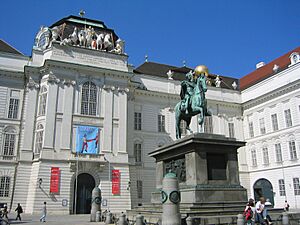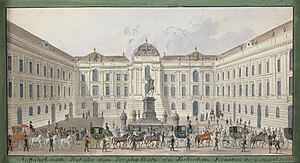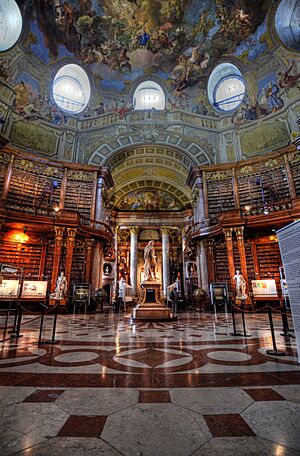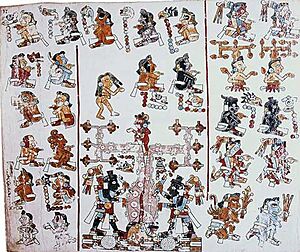Austrian National Library facts for kids
Quick facts for kids Österreichische Nationalbibliothek |
|
|---|---|
 |
|
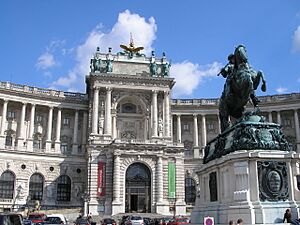 |
|
| Austrian National Library entrance at Heldenplatz | |
| Country | Austria |
| Established | 1368 (as Imperial Court Library) |
| Location | Neue Burg, Hofburg, Innere Stadt, Vienna |
| Coordinates | 48°12′22″N 16°21′59″E / 48.20611°N 16.36639°E |
| Collection | |
| Size | 12,229,285 items |
| Other information | |
| Director | Johanna Rachinger |
| Phone number | +43 1 534 10 |
The Austrian National Library (German: Österreichische Nationalbibliothek) is the biggest library in Austria. It holds over 12 million items, like books, maps, and old writings. This amazing library is found in the Hofburg palace in the center of Vienna. It started a very long time ago, in 1368, and was first called the Imperial Court Library. After the old monarchy ended in 1920, it became the Austrian National Library. Besides its huge collections, the library also has four museums.
Contents
A Look Back: The Library's Beginnings
The story of this library goes all the way back to the Middle Ages. An Austrian Duke named Albert III (who lived from 1349 to 1395) was very interested in books. He gathered many books from Vienna's old storage areas and put them into a library. He even had important books translated from Latin into German.
One of the oldest books in the library belonged to Albert III. It's called the "Holy Gospels" and was made in 1368. A priest named Johannes of Troppau carefully copied the four Gospels from the Bible using gold letters and beautiful pictures.
Later, Frederick III, Holy Roman Emperor (1415–1493) also brought valuable books to Vienna. Then, Maximilian I, Holy Roman Emperor (1459–1519) added many important books from Burgundy and France. These books were so valuable they were worth a huge amount of money at the time!
At first, the library's books were kept in different places, like Wiener Neustadt, Vienna, and Innsbruck. Over time, more and more scientific books were added, and scholars even donated their own collections.
The first main librarian, Hugo Blotius, was appointed in 1575. His job was to organize the library, which already had about 9,000 books. He made sure new books were added regularly.
In 1624, a rule was made that copies of all new books published in Austria had to be sent to the Imperial Library. This helped the library grow even more.
The Grand Baroque Era
In 1722, Emperor Charles VI, Holy Roman Emperor decided the library needed a grand, permanent home. He ordered a beautiful new building to be constructed in the Hofburg palace. This building was designed by famous architects and opened in the 18th century.
One of the most valuable additions during this time was the huge collection of Prince Eugene of Savoy. He owned 15,000 books, including many rare ones from France and Italy. The main hall of the library, called the State Hall, soon held about 200,000 books!
Later, during the time of Empress Maria Theresia, doctors Gerard van Swieten and his son Gottfried van Swieten helped add many scientific books to the collection. Gottfried van Swieten also introduced a new system using cards to keep track of all the books, which made it much easier to find things.
Changes in the Austrian Empire
After the old Holy Roman Empire ended and the Austrian Empire began, the library was reorganized again. It was seen as a library for students, a national library for Austria, and a special library for the Hofburg palace.
The library started collecting books not just in German, but also in Slavic and Hungarian languages, reflecting the many different cultures in the Austrian Empire. However, some of the Hungarian books later moved to Budapest.
In 1848, during a time of big changes and protests, the library was in danger when the Hofburg palace was bombed. Luckily, it survived! An important collection of ancient writings on papyrus was also added around this time.
The Library in Modern Times
After Austria became a republic in 1920, the Imperial Library was officially renamed the Austrian National Library.
During the Nazi period, many books that had been taken from their owners were brought to the library. After World War II, the library kept many of these books. However, in 2003, the library started working to return these books to their rightful owners, especially those taken from Jewish Austrians. This process is still ongoing.
In 1966, many parts of the library's collections were moved to the Neue Burg wing of the Hofburg palace, where new reading rooms were created. The library continued to grow, and by 1992, it held about 4 million items.
For a long time, the library used physical cards to organize its books. But since 1995, it has used an electronic system, which became available online in 1998.
How the Library Works Today
Since 2002, the library has been able to manage its own budget and staff. The government provides some money, but the library also earns funds through sponsorships, copying services, and renting out its spaces. It has a central management team and different departments for things like managing collections, helping visitors, and providing information.
The library's main job is to collect and keep every book and electronic publication made in Austria. Publishers must send copies of their works to the National Library. The library also collects books by Austrian authors published abroad and works about Austrian culture.
The library works with universities, schools, and adult education programs to help people learn. Overall, the library has more than seven million items, with about three million of them being printed books.
The Prunksaal: A Grand Hall
The Prunksaal (which means "State Hall") is the most impressive part of the old imperial library. It's located within the Hofburg palace. This grand hall was started in 1721 and finished in 1723.
Inside, you'll see amazing sculptures and beautiful paintings on the ceiling, called frescoes. These paintings show themes of "war" and "peace" and celebrate Emperor Charles VI and the Habsburg family. There are also marble statues of emperors and four huge globes made by Vincenzo Coronelli.
During the time of Empress Maria Theresa, the dome of the hall needed repairs. An architect strengthened it with an iron ring, and the ceiling paintings were restored. The hall was also extended to connect it to other parts of the palace.
Amazing Collections
The Austrian National Library has many special collections:
Manuscripts and Rare Books
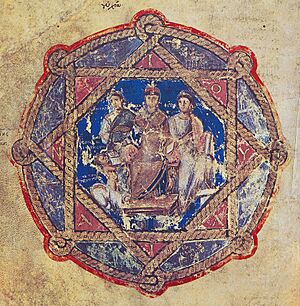
This collection holds old handwritten documents, called manuscripts, from the 4th century up to today. They come from many different cultures. A very famous item is the Vienna Dioscurides, an ancient book from the 7th century with detailed plant drawings. It's so important that UNESCO has recognized it as a "Memory of the World."
Map Collection and Globe Museum
The map collection has maps dating back to the 16th century. It also includes the unique Globe Museum, which opened in 1956. It's the only public museum in the world dedicated to globes! It has over 380 globes, some from the 16th century.
Another treasure here is the Atlas Blaeu-Van der Hem from the 17th century. It's a huge set of 50 volumes with over 2,400 maps and drawings. It's considered one of the most beautiful atlases ever made and is also recognized by UNESCO.
Papyrus Collection and Papyrus Museum
The papyrus collection is one of the largest in the world! It started with a private collection given to Emperor Franz Joseph I of Austria in 1899. It contains about 180,000 items from 1500 BCE to the 16th century CE. Besides papyri, it has writings on clay, wood, stone, leather, and even gold and silver. This collection is also a UNESCO "Memory of the World."
The Papyrus Museum, located in the library, displays about 200 of these ancient objects.
Music Collection
Since 1826, the music collection has gathered many musical scores and first editions of works by famous composers like Anton Bruckner. It also has many recordings, like records and CDs, and even handwritten notes from composers.
Incunabula, Old and Precious Prints
This collection holds very old and valuable printed books. "Incunabula" are books printed before the year 1500. This collection is one of the five largest in the world for these early printed books. It also includes rare and valuable prints from later periods, as well as Chinese and Japanese printings.
Planned Languages and Esperanto Museum
This department focuses on materials related to "planned languages," which are languages created by people, like Esperanto.
Women's and Gender Studies
The "Ariadne" department collects and shares information about women's history and their contributions to society in Austria. It started in 1992 and has been digitizing its materials to make them more accessible.
Austrian Web Archive
Since 2009, the library has been saving websites, creating a "web archive." It collects websites about topics like women's studies, media, and politics. It also archives sites related to important events, such as the 100th anniversary of the First Austrian Republic and the pandemic. You can research these archived websites at the library and other partner libraries.
More Collections at the Austrian National Library
- Department of Broadsheets, Posters and Ex Libris: Over 330,000 items like posters and special bookplates.
- Department of Manuscripts, Autographs and Closed Collections: Ancient to modern handwritten documents from many cultures.
- Department of Music: One of the world's largest music libraries, with many original musical writings.
- Austrian Literary Archives
- Picture Archive
- Department of Incunabula, Old and Precious Books: Includes books printed before 1500 and other rare prints.
- Archives of the Austrian Folk Song Institute
- Austrian National Library Museums
- State Hall
- Globe Museum: 380 globes and scientific tools made before 1850.
- Papyrus Museum: A huge collection of ancient documents, mostly on papyrus.
- Department of Planned Languages and Esperanto Museum
See also
- Codex Vindobonensis B 11093
- Codex Vindobonensis Philos. 75
- Codex Vindobonensis Philos. 157
- Codex Vindobonensis Mexicanus I
- Codex Vindobonensis Lat. 502
- Fayyum Fragment (P. Vienna G. 2325)


